Plasma pharmacokinetics and tissue disposition of novel dextran-methylprednisolone conjugates with peptide linkers in rats
- PMID: 19780131
- PMCID: PMC3415712
- DOI: 10.1002/jps.21934
Plasma pharmacokinetics and tissue disposition of novel dextran-methylprednisolone conjugates with peptide linkers in rats
Abstract
The plasma and tissue disposition of two novel dextran prodrugs of methylprednisolone (MP) containing one (DMP-1) or five (DMP-5) amino acids as linkers were studied in rats. Single 5-mg/kg doses (MP equivalent) of each prodrug or MP were administered intravenously, and blood and tissue samples were collected. Prodrug and drug concentrations were quantitated using HPLC, and noncompartmental pharmacokinetic parameters were estimated. Whereas conjugation of MP with dextran in both prodrugs substantially decreased the clearance of the drug by approximately 200-fold, the accumulations of the drug in the liver, spleen, and kidneys were significantly increased by conjugation. However, the extent of accumulation of DMP-1 in these tissues was substantially greater than that for DMP-5. Substantial amounts of MP were regenerated from both prodrugs in the liver and spleen, with the rate of release from DMP-5 being twice as fast as that from DMP-1. However, the AUCs of MP regenerated from DMP-1 in the liver and spleen were substantially higher than those after DMP-5. In contrast, in the kidneys, the AUC of MP regenerated from DMP-5 was higher than that after DMP-1 administration. These data suggest that DMP-1 may be more suitable than DMP-5 for targeting immunosuppression to the liver and spleen.
2009 Wiley-Liss, Inc. and the American Pharmacists Association
Figures
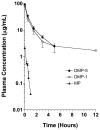
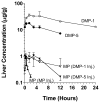
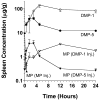
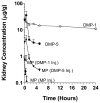
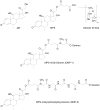
Similar articles
-
Hepatic immunosuppressive effects of systemically administered novel dextran-methylprednisolone prodrugs with peptide linkers in rats.J Pharm Sci. 2012 Oct;101(10):4003-12. doi: 10.1002/jps.23274. Epub 2012 Jul 24. J Pharm Sci. 2012. PMID: 22829462 Free PMC article.
-
Dextran-methylprednisolone succinate as a prodrug of methylprednisolone: plasma and tissue disposition.J Pharm Sci. 2001 Dec;90(12):2078-87. doi: 10.1002/jps.1158. J Pharm Sci. 2001. PMID: 11745766
-
Dextran-methylprednisolone succinate as a prodrug of methylprednisolone: dose-dependent pharmacokinetics in rats.Int J Pharm. 2001 Oct 23;229(1-2):173-82. doi: 10.1016/s0378-5173(01)00854-7. Int J Pharm. 2001. PMID: 11604270
-
Emerging nanoparticle platforms to improve the administration of glucocorticoids.J Control Release. 2023 Jun;358:273-292. doi: 10.1016/j.jconrel.2023.04.039. Epub 2023 May 8. J Control Release. 2023. PMID: 37127077 Review.
-
Lipophilic Conjugates of Drugs: A Tool to Improve Drug Pharmacokinetic and Therapeutic Profiles.Pharm Res. 2021 Sep;38(9):1497-1518. doi: 10.1007/s11095-021-03093-x. Epub 2021 Aug 31. Pharm Res. 2021. PMID: 34463935 Review.
Cited by
-
Hepatic immunosuppressive effects of systemically administered novel dextran-methylprednisolone prodrugs with peptide linkers in rats.J Pharm Sci. 2012 Oct;101(10):4003-12. doi: 10.1002/jps.23274. Epub 2012 Jul 24. J Pharm Sci. 2012. PMID: 22829462 Free PMC article.
References
-
- Evans R, Manninen D, Dong F, Ascher N, Frist W, Hansen J, Kirklin J, Perkins J, Pirsch J, Sanfilippo F. Immunosuppressive therapy as a determinant of transplantation outcomes. Transplantation. 1993;55:1297–1305. - PubMed
-
- Wiesner R, Ludwig J, Krom R, Steers J, Porayko M, Gores G, Hay J. Treatment of early cellular rejection following liver transplantation with intravenous methylprednisolone. The effect of dose on response. Transplantation. 1994;58:1053–1056. - PubMed
-
- Volpin R, Angeli P, Galioto A, Fasolato S, Neri D, Barbazza F, Merenda R, Del Piccolo F, Strazzabosco M, Casagrande F, Feltracco P, Sticca A, Merkel C, Gerunda G, Gatta A. Comparison between two high-dose methylprednisolone schedules in the treatment of acute hepatic cellular rejection in liver transplant recipients: a controlled clinical trial. Liver Transpl. 2002;8:527–534. - PubMed
-
- Millis JM. Treatment of liver allograft rejection. Liver Transpl Surg. 1999;5:S98–S106. - PubMed
-
- Adams D, Neuberger JM. Treatment of acute rejection. Semin Liver Dis. 1992;12:80–87. - PubMed
Publication types
MeSH terms
Substances
Grants and funding
LinkOut - more resources
Full Text Sources

